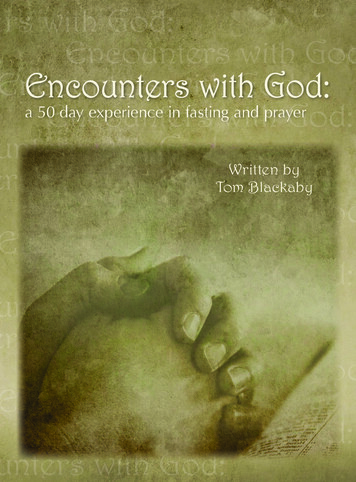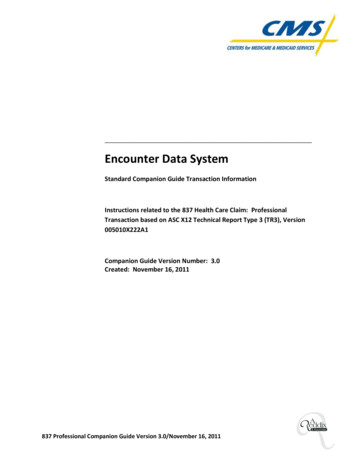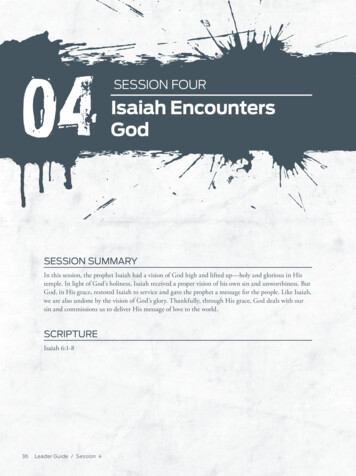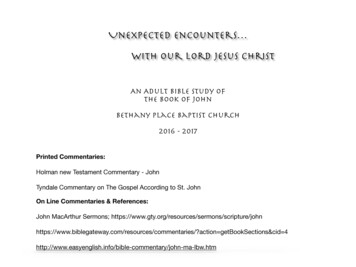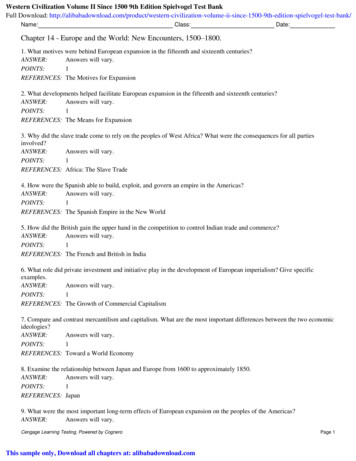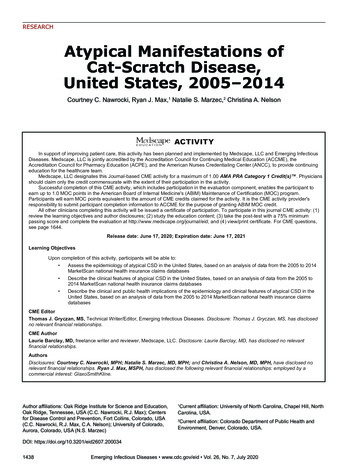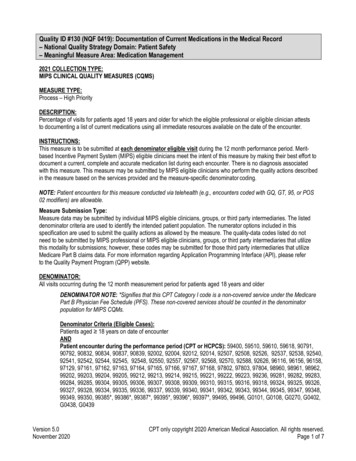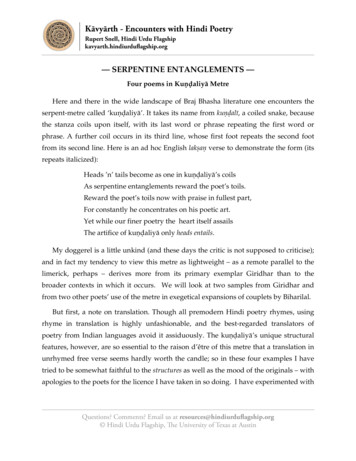
Transcription
Kāvyārth - Encounters with Hindi PoetryRupert Snell, Hindi Urdu Flagshipkavyarth.hindiurduflagship.org— SERPENTINE ENTANGLEMENTS —Four poems in Kuṇḍaliyā MetreHere and there in the wide landscape of Braj Bhasha literature one encounters theserpent-metre called ‘kuṇḍaliyā’. It takes its name from kuṇḍalī, a coiled snake, becausethe stanza coils upon itself, with its last word or phrase repeating the first word orphrase. A further coil occurs in its third line, whose first foot repeats the second footfrom its second line. Here is an ad hoc English lakṣaṇ verse to demonstrate the form (itsrepeats italicized):Heads ’n’ tails become as one in kuṇḍaliyā’s coilsAs serpentine entanglements reward the poet’s toils.Reward the poet’s toils now with praise in fullest part,For constantly he concentrates on his poetic art.Yet while our finer poetry the heart itself assailsThe artifice of kuṇḍaliyā only heads entails.My doggerel is a little unkind (and these days the critic is not supposed to criticise);and in fact my tendency to view this metre as lightweight – as a remote parallel to thelimerick, perhaps – derives more from its primary exemplar Giridhar than to thebroader contexts in which it occurs. We will look at two samples from Giridhar andfrom two other poets’ use of the metre in exegetical expansions of couplets by Biharilal.But first, a note on translation. Though all premodern Hindi poetry rhymes, usingrhyme in translation is highly unfashionable, and the best-regarded translators ofpoetry from Indian languages avoid it assiduously. The kuṇḍaliyā’s unique structuralfeatures, however, are so essential to the raison d’être of this metre that a translation inunrhymed free verse seems hardly worth the candle; so in these four examples I havetried to be somewhat faithful to the structures as well as the mood of the originals – withapologies to the poets for the licence I have taken in so doing. I have experimented withQuestions? Comments? Email us at resources@hindiurduflagship.org Hindi Urdu Flagship, The University of Texas at Austin
Serpentine Entanglements - Four Poems in KuṇḍaliyāRupert Snell, Hindi Urdu Flagshipdifferent line lengths, settling on a pentameter line for all but the first of the four, whichcalled for a longer structure.Giridhar KavirayFor many people, mention of the kuṇḍaliyā brings to mind the poet Giridhar, orGirdhar, an obscure 18th-century practitioner of the form who bore the title kavirāy,‘prince of poets’ or ‘poet of princes’ – an apparent laureateship bestowed by somepatron or merely assumed by the poet himself (though some scholars explain it as a titleof the Bhat caste, which they assume for him on this basis alone). Giridhar’s verses areindividual autonomous compositions; they are much anthologized, though their historyis unclear and collections vary quite widely in the number and content of their verses.Whatever the historical case may be, Giridhar writes with wit and panache; he wouldhave been good company. Here is a Giridhar kuṇḍaliyā from Lallu Lal’s Fort Williamanthology, Sabhā Bilās (Gilbertson 1900:312).!"का ब&'यौ फ ट - न/ ग2ह लीनी हाथ ।च7 राह - जात ; ब धी तमाक? साथ ॥ब धी तमाक? साथ ग/ल कौ ध धा भBCयौ ।गई सब Eचता Fर आग Hखत मन फ?Cयौ ॥कह 2गरधर क2वराय जK जम कौ आयो M"का ।जीव ल/ गया काल हाथ - रह गयौ !"का ॥His hand, it held the mouthpiece firm, with hookah sashed & stored;Tobacco bound in heart and belt, he ambled off abroad.He ambled off abroad and was to journey’s task full blind,His cares all flew off, far away; a flame would charm his mind.Then came, says Poet Giridhar, a chit from Yama’s land:Death bore away his life while lay the hookah in his hand.This is not quite a premodern warning of the risks of smoking (though Yama is thegod of Death, and his ‘chit’ is certain in both content and delivery), but the verse maymark the first whiff of तमाक% (Persian tambākū) in Hindi writing. Elsewhere in Giridhar’scorpus we find some of the first recorded loanwords from English in Hindi poetry:2Kāvyārth: Encounters with Hindi Poetry
Serpentine Entanglements - Four Poems in KuṇḍaliyāRupert Snell, Hindi Urdu Flagshipwords such as 'डसिमस ‘dismiss’ (rhyming with 'कसिमस ‘raisin’; Gupta 1977:116) presagethe tsunami of English that would one day arrive on Hindi’s shores.The stanza’s message, a memento mori wrapped in whimsy, is typical of the fewhundred verses attributed to Giridhar, in whose writing spiritual homilies rubshoulders with observations on the world and its works; this kind of variegated subjectmatter is often designated by the catch-all genre title Nīti, ‘prudent counsel’. Such adesignation denotes in part a contradistinction from Bhakti and Rīti – complementarygenres in which devotional and mannerist predominate respectively – rather than aclearcut range of topics or topoi, and in fact Giridhar’s gaze is quite wide-ranging. Afascination with the world competes with an alleged desire to transcend it; Giridharrelishes the aesthetic delight of verse composition even as he writes pieties designed toerode the very legitimacy of worldly pleasure.Many of Giridhar’s verses read like observations of worldly circumstances that thepoet had himself experienced, perhaps in the courts that gave him patronage. Did hehave British powers in mind when describing the Wellsian usurping donkeys, crowsand jackals below? (Gilbertson 1900:307)साइO घोड़न R अछत गदहन आयौ राज ।कौआ लीज/ हाथ - Fर कीिजय/ बाज ॥Fर क?िजय/ बाज राज ऐसो ही आयौ ।Xसह कYद - 2कयो Zयार गजराज चढ़ायौ ॥कह 2गरधर क2वराय जह& यह बBझ बड़ाई ।तह& न कीज/ स&झ स]रXह चिलय/ साइO ॥ ३५Sir, steeds abound, yet donkeys rule the land;Put off the hawk, and take the crow to hand!Take crow to hand! The crown is cheaply gained,The jackal’s jeweled and the lion’s enchained.Says Giridhar, where people thus aver,Stay not till even – leave at morning, Sir!3Kāvyārth: Encounters with Hindi Poetry
Serpentine Entanglements - Four Poems in KuṇḍaliyāRupert Snell, Hindi Urdu FlagshipThis is one of several of Giridhar’s poems to circumvent the structural rule of thekuṇḍaliyā by opening and hence closing the poem with the vocative साइ , a vernacularderivate of ,वामी meaning ‘sir, sire, sirrah’. (An unsubstantiated tradition attributesthese साइ verses to Giridhar’s wife!) True, this stratagem upholds the letter of thecompositional law – in that the same word does indeed appear at both beginning andend – but surely not its spirit, which involves combining the same word into twodifferent syntactic and/or semantic contexts rather than just throwing in a particle thatwould fit in anywhere. One feels cheated, rather as by Lear’s limericks whose final linerepeats the opening rhyme.Kuṇḍaliyā as CommentaryFew poets except Girdhar attempt more than momentary forays into kuṇḍaliyā territory(a rare example is the Bhajan Kuṇḍaliyā līlā of the 17th-century Rādhāvallabhī poetDhruvdas: Swami Hit Das 1996); but the structure of the kuṇḍaliyā gives the metre aninteresting new life as a medium for poetic commentary. The first couplet of thekuṇḍaliyā is a dohā, while the second and third couplets are in rolā metre, whose firstfoot matches in length the second foot of the dohā (thus accommodating the repeatexemplified by Giridhar’s /र कीिजए बाज above). This formula of ‘one dohā couplet tworolā couplets’ allows an original dohā by one poet to be extended by another poet in afour-line exegetical variation. The repeated foot yields a seamless transition betweenmūla and commentary; and the final-word repeat in line six brings the commentatorback, willy-nilly, to the word(s) of the original poet! This is such a perfect exegeticaldevice, and the dohā such a favourite metre, that one might have expected theconvention to be widely used; but in fact it is quite rare. However, among the dozens ofcommentaries on the Satsaī of Bihari (featured elsewhere in this का4याथ6 series), at leasttwo – Harishchandra and one ‘Pathan Sultan’ – have employed kuṇḍaliyā metre in themethod just described.Harishchandra of Banaras sat on the cusp between traditional and modern modes ofliterature. Among the contributions that he made to the Braj tradition in his short life4Kāvyārth: Encounters with Hindi Poetry
Serpentine Entanglements - Four Poems in KuṇḍaliyāRupert Snell, Hindi Urdu Flagship(1850-85) was a series of kuṇḍaliyās based on 85 couplets of Bihari’s Satsaī, producingbetween one and five kuṇḍaliyā versions for each dohā. Here is an example, in whichhe takes a nostalgic miniature and expands its narrative and descriptive horizons.Bihari’s original dohā is colour-coded as a reminder of its status as a poem in its ownright.सघन क ज छाया सKखद सीतल मaद समीर ।मन b/ जात अजc व; वा जKमKना R तीर ॥वा जमKना R तीर सोई धK2न आdिखन आव/ ।कान eनK धK2न आ2न कोई औचक िजिम नाव/ ॥सK2ध भBल2त ह2रच द लखत अजgd वh दाबन ।आवन चाहत अबXह 2नक2स मनK Zयाम सरस घन ॥In groves’ sweet shade, where breezes softly blowMy mind once more on Jumna’s shore would go.On Jumna’s shore there flows the stream serene;May none dive in and flout the fluted scene.Vrindaban’s visions haunt my mind in droves;My heart with cloud-dark Shyam delighting roves!Harishchandra uses a device that playfully works a variation on the statutory lastline repeat of first-line words, refashioning Bihari’s original सघन as (सर-) स घन; mytranslation seeks to emulate this by reworking ‘In groves’ as ‘(delight-) ing roves’ –though this succeeds as an eye-rhyme only, as the auditory qualities of the two Englishphrases differ. The rhyme in turn requires some license in the penultimate line also, asrhymes for ‘roves’ do not exactly come along in er . droves.The Satsaī commentator known as ‘Pathan Sultan’ is much less well-known than thecelebrated Harishchandra. George Grierson (1896:10) dates the commentary to ‘aboutA.D. 1700’, and adds that Sultan Pathan, alias Nawab Muhammad Khan, is ‘said tohave been Nawāb of Rājgaṛh, Bhūpāl’. Grierson quotes the following feisty stanza fromthe Nawab, who takes one of Bihari’s gems and strings in onto a necklace of his owndesign.In Bihari’s dohā, the heroine is far too delicate to bear the weight of any5Kāvyārth: Encounters with Hindi Poetry
Serpentine Entanglements - Four Poems in KuṇḍaliyāRupert Snell, Hindi Urdu Flagshipornament, and seems to stagger under the burden of her very beauty alone (whereasher unsteadiness is in fact attributable to the effects of love-making – an example of theclassical apahnuti trope, in which one cause of a symptomor characteristic ‘denies’another). The Nawab expands this idea in new directions. (Source: Ratnakar 1953:209.)भBषन भार सdभा2र; "यj इXह तन सKक मार ।सBधk पाइ न धर परm सोभा ही क भार ॥सोभा ही क भार चलत लचकत क2ट खीनी ।Hnयौ अ2नलK उड़ाइ जौ न होती क चपीनी ॥कह पठान सKलतान तासK अdग अ ग अFषन ।नरी 2कaनरी सKरी आ2द 2तत की 2तय भBषन ॥A jewel’s weight’s not borne by one so slight;with falt’ring step she lugs her lustre’s freight.She lugs her lustre’s freight, flex-waisted maid;The breeze would waft her, but she’s bosom-lade.No blight or blemish ripples beauty’s pool:’Midst nymphs of all the worlds, this one’s a jewel.To extend Bihari’s already-perfect miniaturist poetic vision onto a larger scale is anexercise in gilding the lily; and Pathan and Harishchandra take almost as much libertywith Bihari’s dohās as I, as translator, take with their kuṇḍaliyās. Harishchandra’saddition of a geographically specific ‘Vrindaban’ grounds the aerial poem with anunwelcome literalness, and his insistence that none should spoil the scene by bathing isas disruptive as the noisy plunge itself. The Nawab’s trope of ‘breasts as ballast’ lackssubtlety, though the taking of baroque-like imagery to rococo-like extremes is anaccepted and often effective part of Rīti rhetoric. But whatever the limitations of theirattempts to engage with the greater genius of Bihari, both poets have contributed to therealm and range of the kuṇḍaliyā, which readers may encounter again in theirexplorations of Braj poetry, here and there.- Rupert Snell6Kāvyārth: Encounters with Hindi Poetry
Serpentine Entanglements - Four Poems in KuṇḍaliyāRupert Snell, Hindi Urdu FlagshipSourcesHit Das, Swami (ed.) Bayālīs līlā [of Dhruvdas]. Vrindaban, 1996.Gilbertson, G.W. The Assembly of Mirth.the Sabhá Bilás [compiled by Lallu Lal]. Benares,1900. (This edition is available online through Google Books.)Grierson, G.A., ed., The Satsaiya of Bihari, with a commentary entitled the Lala-Candrika [ofLallu Lal]. Calcutta 1896.‘Ratnakar’, Jagannath Das, Kavivar Bihārī. Benares 1953.Gupta, Kishori Lal (ed.), Giridhar Kavirāy granthāvalī. Allahabad, 1977.Sharma, Hemant (ed.), Bhāratendu samagra. 3rd edn. Varanasi, 1989.7Kāvyārth: Encounters with Hindi Poetry
Kāvyārth: Encounters with Hindi Poetry ornament, and seems to stagger under the burden of her very beauty alone (whereas her unsteadiness is in fact attributable to the effects of love-making - an example of the classical apahnuti trope, in which one cause of a symptom or characteristic 'denies'
